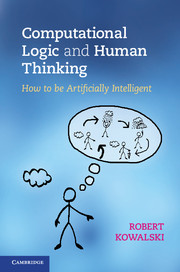Book contents
- Frontmatter
- Contents
- Preface
- Summary and plan of the book
- Introduction
- 1 Logic on the Underground
- 2 The psychology of logic
- 3 The fox and the crow
- 4 Search
- 5 Negation as failure
- 6 How to become a British Citizen
- 7 The louse and the Mars explorer
- 8 Maintenance goals as the driving force of life
- 9 The meaning of life
- 10 Abduction
- 11 The Prisoner’s Dilemma
- 12 Motivations matter
- 13 The changing world
- 14 Logic and objects
- 15 Biconditionals
- 16 Computational Logic and the selection task
- 17 Meta-logic
- Conclusions of the book
- A1 The syntax of logical form
- A2 Truth
- A3 Forward and backward reasoning
- A4 Minimal models and negation
- A5 The resolution rule
- A6 The logic of abductive logic programming
- References
- Index
8 - Maintenance goals as the driving force of life
Published online by Cambridge University Press: 07 September 2011
- Frontmatter
- Contents
- Preface
- Summary and plan of the book
- Introduction
- 1 Logic on the Underground
- 2 The psychology of logic
- 3 The fox and the crow
- 4 Search
- 5 Negation as failure
- 6 How to become a British Citizen
- 7 The louse and the Mars explorer
- 8 Maintenance goals as the driving force of life
- 9 The meaning of life
- 10 Abduction
- 11 The Prisoner’s Dilemma
- 12 Motivations matter
- 13 The changing world
- 14 Logic and objects
- 15 Biconditionals
- 16 Computational Logic and the selection task
- 17 Meta-logic
- Conclusions of the book
- A1 The syntax of logical form
- A2 Truth
- A3 Forward and backward reasoning
- A4 Minimal models and negation
- A5 The resolution rule
- A6 The logic of abductive logic programming
- References
- Index
Summary
What do the passenger on the London Underground, the fox, the wood louse, the Mars explorer and even the heating thermostat have in common? It certainly isn’t the way they dress, the company they keep, or their table manners. It is the way that they are all embedded in a constantly changing world, which sometimes threatens their survival, but at other times provides them with opportunities to thrive and prosper.
To survive and prosper in such an environment, an agent needs to be aware of the changes taking place in the world around it, and to perform actions that change the world to suit its own purposes. No matter whether it is a human, wood louse, robot or heating thermostat, an agent’s life is an endless cycle, in which it must:
repeatedly (or concurrently)
observe the world,
think,
decide what actions to perform, and
act.
We can picture this relationship between the mind of an agent and the world like this:The observation–thought–decision–action cycle is common to all agents, no matter how primitive or how sophisticated. For some agents, thinking might involve little more than firing a collection of stimulus–response associations, without any representation of the world. For other agents, thinking might be a form of symbol processing, in which symbols in the mind represent objects and relationships in the world. For such symbol manipulating agents, the world is a semantic structure, which gives meaning to the agent’s thoughts.
- Type
- Chapter
- Information
- Computational Logic and Human ThinkingHow to Be Artificially Intelligent, pp. 107 - 124Publisher: Cambridge University PressPrint publication year: 2011



